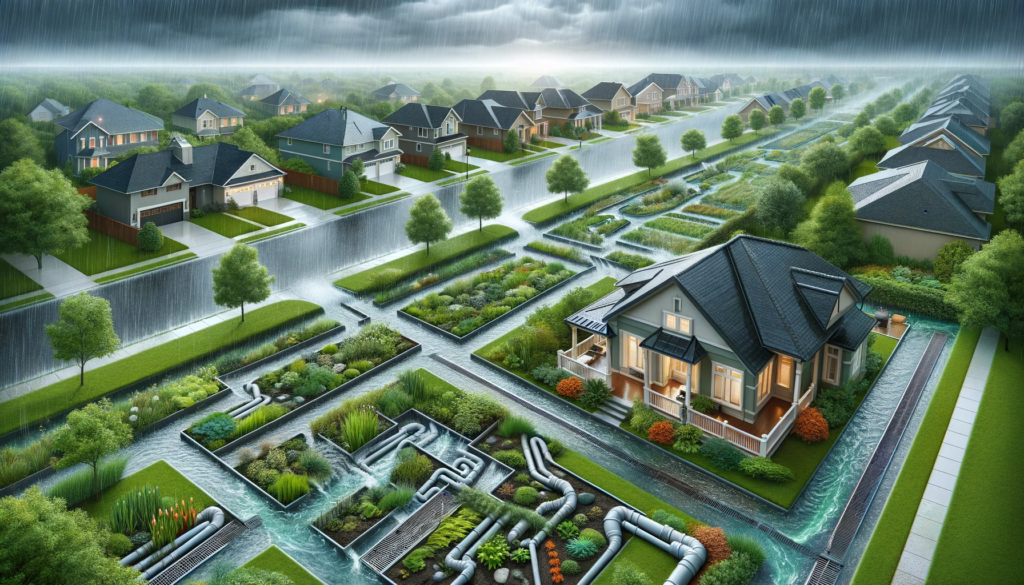Effective Strategies for Managing Drainage in High-Rainfall Areas

Managing drainage effectively is crucial, especially in regions often tackling excessive rainfall. Without adequate drainage systems, properties can suffer from water damage, landscape erosion, and even foundation issues. High-rainfall areas pose unique challenges, requiring specific solutions to handle the massive water influx during storm seasons.
Introduction to Drainage Management
Drainage management is essential for protecting infrastructures and landscapes from the damaging effects of water. In high-rainfall areas, the challenges of managing large volumes of rainwater are intensified, often resulting in flooding and related problems. By understanding the importance of drainage and implementing the right strategies, property owners can prevent potential damage and maintain a healthy environment.
Key Takeaways for Drainage Management in High-Rainfall Areas:
| Challenge | Impact |
|---|---|
| Overloaded Systems | Flooding and water damage |
| Insufficient Erosion Control | Landscape degradation |
| Poor Water Quality | Negative environmental effects |
Implementing the right drainage solutions ensures rainwater is effectively diverted away from buildings and landscapes, reducing the risk of damage and contributing to a safer living space.
Assessing Your Drainage Needs
Before delving into drainage solutions, it’s important to evaluate your property’s specific requirements. A proper assessment will reveal the types of drainage issues you might face and the best approaches to manage them.
Steps for Evaluating Drainage Needs:
- Check the property’s slope and natural water flow.
- Identify areas where water accumulates during heavy rains.
- Inspect existing drain systems for signs of malfunction.
- Consider the soil type and its impact on water absorption.
- Review the landscape’s design and current state.
The findings from a thorough evaluation will be crucial in choosing and designing effective drainage systems.
Drainage Solutions for High-Rainfall Areas
High-rainfall regions require robust and efficient drainage solutions to manage the incessant downpour. From traditional to contemporary, a variety of systems can be implemented to mitigate flood risks and safeguard properties.
Effective Drainage Systems:
- French Drains: capture and redirect subsurface water
- Retention Ponds: hold excess rainwater and release it slowly
- Dry Wells: collect and dissipate water into the ground
Innovative solutions, such as rain gardens and green roofs, not only manage water runoff but also contribute to the area’s biodiversity and aesthetic appeal.
Gutter and Downspout Management
An integral part of any drainage effort, gutters and downspouts need to be attentively managed. Properly sized and regularly maintained gutters prevent water damage to roofs and walls, directing water away from the building’s foundation.
Important Gutter and Downspout Tips:
- Regularly clean gutters to prevent blockages.
- Ensure downspouts divert water at least 10 feet from foundation walls.
- Consider installing gutter guards to reduce debris buildup.
For detailed guidance on maintaining your home’s gutters and downspouts, explore our comprehensive tips here.
Subsurface Drainage Systems
Subsurface drainage systems, like French drains, play a crucial role in high-rainfall environments. These systems are engineered to address water accumulation at the root, literally, by providing an underground conduit for excess moisture.
How French Drains Work:
- Trenching: A trench is dug that slopes away from the property.
- Piping: Perforated pipes are installed to collect subsurface water.
- Filtration: Gravel and landscaping fabric are used to prevent soil from clogging the pipes.
French drains are ideal for preventing water from pooling around foundations and within gardens. For a deeper dive into the types of home drainage systems, including French drains, please visit Understanding Your Home’s Drainage System.
Surface Drainage Solutions
Surface drainage is equally important, especially for immediate rainwater dispersal. Surface solutions facilitate the quick removal of water from hardscaped and landscaped areas, reducing the potential for erosion and damage.
Popular Surface Drainage Methods:
- Rain Gardens: attractively landscaped areas designed to absorb and filter runoff
- Permeable Paving: surfaces that allow water to seep through and replenish groundwater
- Swales and Berms: shallow, linear channels lined with vegetation to manage water flow
Coupled with an aesthetically pleasing design, effective surface drainage can enhance your property’s appeal. To create a synergy between aesthetic and function, see our recommendations on Landscaping and Drainage.
Sustainable Drainage Practices
Adopting sustainable drainage practices is not only better for the environment but also effectively mitigates the impact of heavy rainfall. These eco-friendly options often mimic natural processes to manage runoff and minimize environmental footprints.
Eco-Friendly Options for Drainage:
- Bioswales: Vegetated channels that treat and convey runoff while promoting infiltration.
- Rainwater Harvesting: Collecting rainwater for reuse in irrigation or as greywater.
- Green Roofs: Rooftop gardens that absorb rainwater and provide insulation.
Incorporating these practices can also attract local wildlife, contributing to the ecological health of the area. Further insights on adopting environmental solutions for drainage can be found here.
DIY vs. Professional Installation
When it comes to implementing drainage solutions, homeowners often deliberate between DIY projects and hiring professionals. While DIY can be cost-effective for minor improvements, complex drainage systems typically require professional expertise.
Considerations for DIY vs. Professional Drainage Installation:
- Skill Level: Assess your familiarity with drainage system components and installation processes.
- Project Scale: Larger or more complex projects may necessitate a professional’s precision.
- Time Commitment: Evaluate if you can dedicate the necessary time to the project.
The guidance for DIY enthusiasts or those considering professional installation services is available here.
Regular Maintenance for Optimal Performance
Maintenance is a non-negotiable aspect of effective drainage management. Regular check-ups and corrective measures can prevent minor issues from becoming major problems, especially in regions that experience high rainfall.
Drainage Maintenance Checklist:
- Inspect Drains Regularly: Look for signs of blockage or damage.
- Clear Debris: Keep inlets and outlets of drainage systems clean.
- Monitor Performance: Observe how systems handle heavy rains.
- Arrange Professional Inspections: Schedule annual or biannual checks from a drainage expert.
Not only do these maintenance activities prevent future issues, but they can also extend the service life of your drainage systems. For comprehensive maintenance tips, please refer to our Drain Maintenance Guidance.
Handling Emergencies and Common Problems
Drainage systems in high-rainfall areas are more susceptible to emergencies such as sudden flooding or back-ups. Being prepared for common issues can help you act swiftly to mitigate damage.
Strategies for Drainage Emergencies:
- Quick Assessments: Rapidly identify the source of the problem.
- Pre-Planned Solutions: Have tools and materials on hand for temporary fixes.
- Emergency Contacts: Keep a list of professional service providers readily available.
The ability to handle these unplanned situations effectively can save your property from extensive damage. For urgent drainage issues and how to deal with them, check out our Emergency Drainage Solutions.
The Impact on Home Value and Legal Compliance
Proper drainage is not only a functional element of home management but also plays a significant role in property valuation and legal compliance. Effective drainage systems can prevent structural damage, enhance curb appeal, and ensure adherence to local regulations, all of which contribute to sustaining and increasing the value of your home.
Key Points on Drainage and Property Value:
- Prevention of Damage: Reduces long-term repair costs and maintains structural integrity.
- Aesthetic Appeal: Well-designed drainage solutions improve landscaping and overall appearance.
- Legal Considerations: Compliance with water management laws prevents fines and disputes with neighbours.
Understanding the broader implications of drainage systems is crucial. To gain more insights into how drainage can affect the health of your home and its market value, please visit Drainage and Home Value.
Conclusion
Managing drainage in high-rainfall areas is a multifaceted challenge that requires a thoughtful approach combining assessment, implementation of effective solutions, regular maintenance, and a clear understanding of the impacts on property value and legalities. By employing a mix of traditional, innovative, and sustainable practices, homeowners can create effective water management systems that protect their properties and contribute positively to the environment.
Remember, proactive drainage management is the key to avoiding the pitfalls of extreme weather conditions. Always assess your property’s specific needs, choose the right solutions, perform regular maintenance, and seek professional help when necessary.
We encourage property owners to be vigilant and informed about their drainage needs. For more details on specific drainage topics, explore the wealth of information provided through the various internal links throughout this article.




